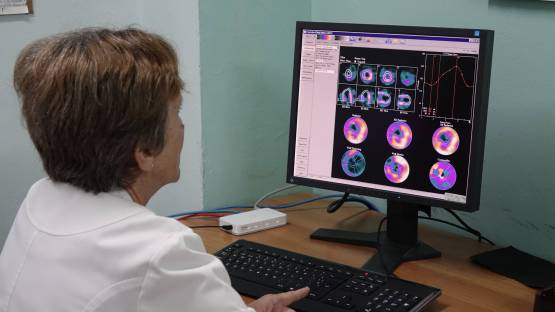Cardiovascular diseases claim almost 18 million lives in the world every year. The burden is particularly heavy in low- and middle-income countries, home to eight of every 10 people who die of these diseases. According to the World Health Organization (WHO), CVDs are the leading cause of death globally, accounting for 32 per cent of global deaths in 2019.
The role of medical imaging techniques, including radiology and nuclear medicine, in facilitating more tailored and effective management of cardiovascular diseases (CVDs), is the focus at the IAEA’s third International Conference on Integrated Medical Imaging in Cardiovascular Diseases (IMIC-2022), taking place this week at the IAEA headquarters in Vienna, Austria.
The conference has gathered over 250 clinicians, scientists and professionals in cardiac imaging in Vienna, while more than 1500 are attending online. The participants have come from 84 countries, as well as 14 professional organizations, to address the most recent advances and challenges in the integrated use of medical imaging in the management of CVDs.
“The IAEA widens global access to life-saving radiation applications, so that no one is left behind. This places us at the heart of the fight against heart disease,” said IAEA Director General Rafael Mariano Grossi, opening the conference. “But it goes further,” he added. “Imaging modalities are cross-cutting. They are pivotal in diagnosis and the selection of appropriate clinical management. By strengthening medical imaging infrastructure for cardiovascular diseases, we fortify health systems to handle other prioritized conditions, as well.”
Cardiovascular diseases are a group of non-communicable diseases of the heart and blood vessels, such as heart attacks and strokes, that are mainly caused by a blockage that impedes blood flow to the heart or brain.
Building on the successes of IMIC-2013 and IMIC-2016, this year’s conference aims to provide an international forum in the field of medical imaging in CVDs to advance patient management, support professional development in terms of new technologies and applications, and strengthen capacities in the use of different imaging modalities in CVD management. All sessions are livestreamed, and registered participants are eligible to receive up to 14 Continuing Medical Education (CME) credits.
Participants at IMIC-2022 are taking part in several clinical sessions addressing specific cardiac diseases, such as coronary artery disease (CAD), heart failure and cardio-oncology. The sessions comprise both plenary and interactive expert lectures on topics related to various medical imaging modalities. Medical imaging modalities are tests such as single photon emission computed tomography (SPECT), positron emission tomography (PET), echocardiography (ultrasound of the heart), computed tomography (CT) and magnetic resonance imaging (MRI). These tests can unveil the pathology of individual patients in detail and, thereby, provide vital insights for all stages of the management of CVDs, including diagnosis, prognosis, treatment and follow-up to decipher stability, improvement or progression of disease. Imaging can also directly guide treatment, whether for surgical planning or image-guided, catheter-based treatments, such as stenting.
Each medical imaging modality has advantages and limitations that must be considered and understood by health care professionals dealing with CVDs. Therefore, the IMIC-2022 conference focuses on a multimodality approach, which combines the benefits of different types of tests, to facilitate the integration of medical imaging techniques into health care systems to improve CVD management.
“Test selection is crucially important,” said Dr Mouaz H. Al-Mallah, 2023 President of the American Society of Nuclear Cardiology (ASNC) and speaker at the event. “Having a multimodality approach and expertise in several types of tests facilitates the selection of the right test at the right time and for the right reason. By selecting the right test, the patient is more likely to undergo less testing overall and receive more effective care.”
The management of CVDs in women is one of the primary challenges also being addressed at the IMIC-2022 conference. Out of 430 million new CVDs cases each year, 250 million occur in women. However, women are often underdiagnosed and undertreated, due to the lack of awareness of the symptoms related to coronary diseases in female patients.
“This conference is an ideal platform for professionals from all over the world to discuss the specific needs of female patients and access up-to-date information,” said Dr Amalia Peix, Professor and Senior Researcher at the Institute of Cardiology in Havana, Cuba, who gave a lecture on cardiovascular diseases in women.
The IAEA carries out initiatives, such as training courses, fellowships, expert missions and international conferences, to support global coordinated efforts to improve CVDs management worldwide, assisting countries in establishing and strengthening their capabilities in nuclear medicine and radiology. The IAEA also promotes capacity building in medical imaging through technical cooperation projects and coordinated research projects. The IAEA has developed a publication, ‘Imaging of Ischemic Heart Disease in Women. A critical review of the literature’, to be released on Friday, 16 December, which aims to provide more precise data to advance symptom-recognition in patients.
To follow the conference discussions, watch the live video stream or register as an observer.
Follow the conference on social media with #IMIC2022 and #Atoms4Health.







